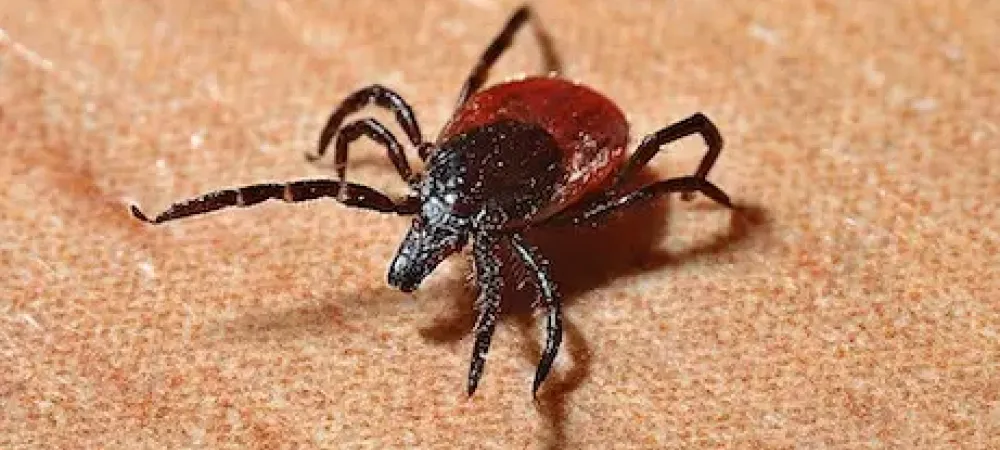Everything You Need to Know About Minnesota Fleas & Ticks

It’s August in Minnesota, and while you may be thinking about getting the kids ready for back to school, now is not the time to let your guard down when it comes to insects and pests. Hidden dangers lurking in all corners of your yard, just waiting to pounce on an unsuspecting adult, pet, or child.
When the weather is hot and humid, as it usually is here in Minnesota in August, fleas, and ticks abound. They love to hang out in the shady areas of your yard, under trees, bushes, and in tall, thick grass. The best way to prepare yourself is to be educated. Know what fleas and ticks look like, the dangers they carry, and how to prevent them from getting into your home and keep them outside. Read on to learn everything you need to know regarding fleas and ticks because they are not going anywhere just yet.
How to Identify Ticks
Ticks are also wingless and come in a variety of colors, including grayish-white, brown, black and yellow. They are flat and oval with eight legs and approximately one eight of an inch.
How to Identify Fleas
Fleas are wingless creatures with narrow bodies no bigger than 2.5 mm in length. They are reddish-brown and have shiny exoskeletons. Their bodies are covered in hair to help them attach to their host and easily move under a host’s fur.
Where Do Fleas and Ticks Live in Minnesota?
Both fleas and ticks thrive in dark, shaded areas including in the woods, around trees, and tall grassy areas. The most common places you’ll find them in your backyard are:
- Treehouses
- Playscapes
- Tall grasses – both ornamental grass and unmowed turfgrass
- Under structures like decks and porches
- Shaded areas of your lawn
Danger of Ticks
Ticks are dangerous because they can carry harmful diseases for both you and your pets. The most common disease that ticks carry is Lyme disease. This illness has symptoms that often mimic the flu, such as fever, chills, and fatigue. But it can become more serious if not treated attacking your major organs. Other diseases that ticks carry include:
- Anaplasmosis
- Babesiosis
- Ehrlichiosis
- Powassan Virus disease
- Borrelia miyamotoi disease
- Rocky Mountain Spotted Fever
- Tularemia
Danger of Fleas
Fleas are more prone to harass your beloved furry friends, but flea fecal matter and saliva can cause allergic reactions in humans as well. Diseases they carry include Murine Typhus, tapeworm, cat-scratch disease, and plague. The biggest problem with fleas is that they like to hitch a ride on the back of your dog or cat, sucking their blood for their next meal, and end up traveling inside your home. A female flea can produce up to 2,000 eggs in one lifetime, making them quite the challenge to get rid of once they get inside.
Ways to Prevent Fleas and Ticks From Invading Your Home
Keep Your Yard Maintained and Clean
Because fleas and ticks like to hide amongst the tall grass, trees, and shrubs, it’s essential to keep your yard as neat and clean as possible. This includes keeping your grass cut, your trees and bushes trimmed, and landscape beds cleaned. Be sure no branches are touching your house and clean up any falling debris as soon as it occurs, so these nasty critters can’t make it to their new home.
Keep Your Property Clean and Unattainable
Fleas and ticks are also attracted to anything that smells of blood, so keep raccoons, deer, and feral cats out of your yard by making sure your trash cans are sealed, keeping your grill covered, and cleaning up any food crumbs left behind.
Other ways to help prevent fleas and ticks include:
- Place all hardscaping structures such as fire pits, water fountains, benches, and patios away from tall grass, trees, and shrubs.
- Wear protective clothing. If you go hiking or need to do work in the backyard, wear long-sleeve shirts and long pants.
- When returning from the woods, or any highly shaded area, always inspect your clothing for any sign of fleas and ticks. Wear light-colored clothing so that they are easier to spot when you return.
- Use homemade tick sprays such as cedar oil and other essential oils.
- Groom your pet regularly. Brush your pets with a flea comb after they come inside. It will remove any eggs, adults, or flea fecal matter.
- Use a flea and tick preventive for your pet. Most are sold at your local pet store or can be purchased through your veterinarian.
- Invest in professional flea and tick control with your friends at Showcase Lawn
Stop Fleas From Getting Inside Your Home With Showcase Lawn Care
The experts at Showcase Lawn Care can help protect your family and pets by keeping the fleas and ticks outside. With our Flea and Tick Control, we can eradicate fleas and stop larvae and pupae before they have a chance to reach adulthood and reproduce further. Don’t take any more chances. Contact us today and learn more. You can reach us through our online contact form or phone at (763) 415-7383.
